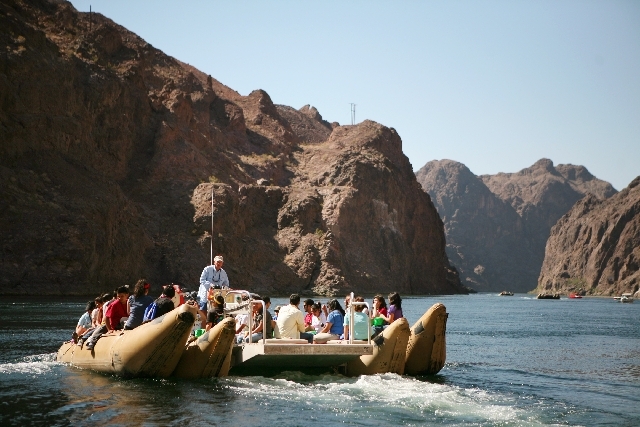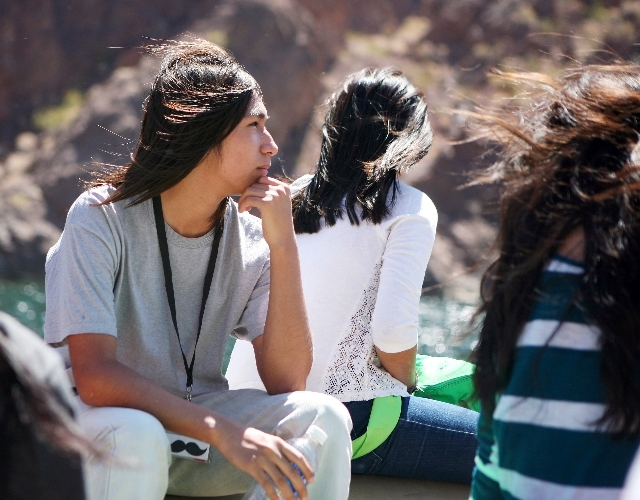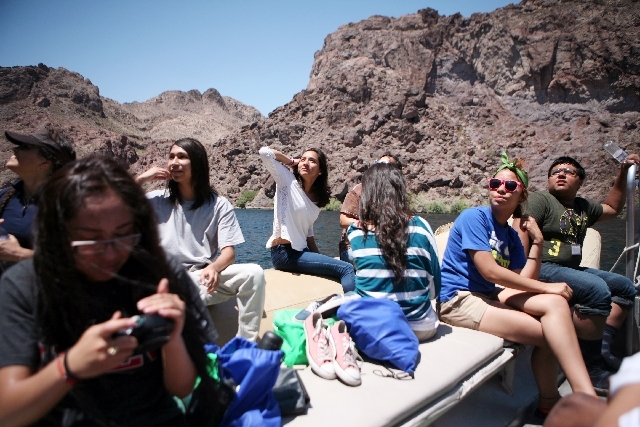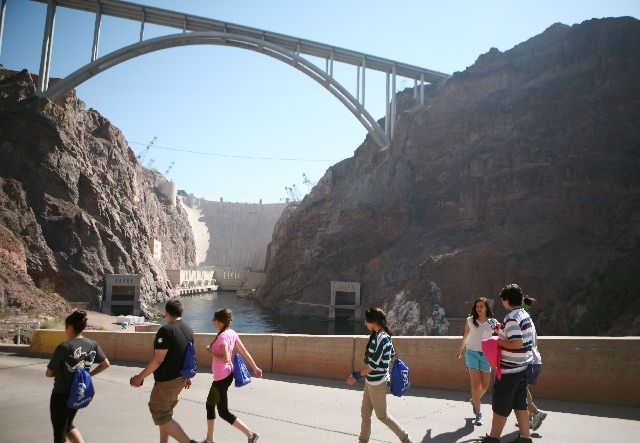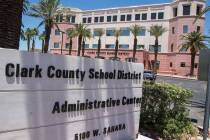Southern Nevada nature opens eyes of Hispanic youth
Brushing the hair out of his eyes, Julian Elias tilts his head back and gazes up at something most Las Vegans have seen.
The Hoover Dam.
But few have the security clearance to view it from the bottom of Black Canyon, a location accessed by a winding workers road reachable only by those with a key code to open the gate.
Standing in the shadow of Hoover Dam’s 726-foot wall almost directly beneath the bypass bridge, the teenager’s usually placid expression gives way to a voiceless “wow.”
“I’ve never done anything like this,” he says.
A 400-horsepower pontoon raft pulls up to the shore. It’s his ride for a 12-mile trip downriver.
It’s about to be a day of many firsts for Elias and 260 other Hispanic high school and college students. They’ve descended on Southern Nevada from all over the country to learn about everything from dining etiquette to college financial aid opportunities and how to land government careers in the U.S. Department of the Interior, such as the jobs at the Lake Mead National Recreation Area.
At the annual, week long gathering of the League of United Latin American Citizens, the youths — who are usually immigrants or children of immigrants — are learning how to excel in America, “to explore,” said Paul Dunnand, vice president for the league’s youth in the Southwest.
“It’s good that they get out, open their eyes,” said Dunnand, who attends Texas A&M.
Hispanic youth, a growing ethnic group, tend to struggle in American schools.
At 44 percent of all students, Hispanic students make up the Clark County School District’s largest ethnic group. But Hispanic students in the nation’s fifth-largest district commonly have one of the lowest graduation rates, usually falling below 60 percent, whereas Caucasians and Asians often exceed a
75 percent graduation rate.
Yaritza Velazquez, born in Mexico and raised in Las Vegas, didn’t even consider graduate school until she learned last year at the conference that there is financial aid for students like her. But most of her peers don’t even consider college, period, she said. Their parents may not even have finished high school.
“But the government can help you,” said Velazquez, who is studying health care administration at the University of Nevada, Las Vegas, and also rode the raft Tuesday.
The excursion for students held a deeper purpose than just sightseeing.
“Latinos are vastly underrepresented in STEM (science, technology, engineering and mathematics) fields,” said league President Margaret Moran, who thanked the Department of the Interior for trying to inspire students to become wildlife biologists, hydro-engineers, park rangers and more by thrilling them with the beauty of federal lands.
“These are the kinds of experiences that will stick with them,” said Celinda Pena, adviser to the director of the National Park Service, which hires many in STEM fields.
Groups of Hispanic youths also hiked in Red Rock National Conservation Area on Tuesday, while others shadowed engineers and electricians inside Hoover Dam. In Moapa Valley National Wildlife Refuge, youths learned about the habitat restoration bring done by the U.S. Fish and Wildlife Service to protect endangered species.
Then there were the 50 students aboard a pair of rafts motoring down the Colorado River.
“I want to see a bighorn sheep,” said Velazquez, wind spraying water over the bow and onto her sunglasses as she eyes the volcanic cliffs jutting out of the river.
“Find the white spot,” Capt. David Block of Black Canyon River Adventures said. “If the white spot moves, it’s the south end of a northbound sheep.”
Within a couple of hours, Velazquez spots a few sheep scaling the sharp cliffs. They’re two rams nipping at each other and banging horns as they chase a fleeing ewe.
Elias, admittedly a “shy person,” came for the company. As an incoming sophomore at Canyon Springs High School in North Las Vegas, he’s not thinking about careers yet or financial aid.
While everyone else wet their toes in the 50-degree water during a break, and some walked up to their hips, he cannonballed from the raft. Clothes and all.
“I’m a shy person. That’s why I wanted to join this — to meet people,” he had said earlier that morning before boarding the raft.
Contact reporter Trevon Milliard at tmilliard@reviewjournal.com or 702-383-0279.



